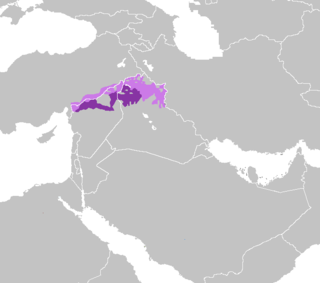North Mesopotamian Arabic
| North Mesopotamian Arabic | |
|---|---|
| Native to | Iraq, Iran, Syria, Turkey, Cyprus |
Native speakers | (8.7 million cited 1992-2014)[1] |
Afro-Asiatic
| |
| Dialects | |
| Arabic alphabet | |
| Language codes | |
| ISO 639-3 | ayp |
| Glottolog | nort3142 |
| ELP | North Mesopotamian Arabic |
 | |
North Mesopotamian Arabic (also known as Moslawi [meaning 'of Mosul'] or Mesopotamian Qeltu Arabic) is a variety of Mesopotamian Arabic spoken north of the Hamrin Mountains in Iraq, in western Iran, northern Syria, and in southeastern Turkey (in the eastern Mediterranean Region, Southeastern Anatolia Region, and southern Eastern Anatolia Region).[2] The peripheral Turkish varieties in Siirt, Muş and Batman are quite divergent. (See Anatolian Arabic.) Like other Mesopotamian Arabic varieties and Levantine Arabic, it shows signs of an Aramaic substrate.[3]
Cypriot Arabic shares a number of common features with North Mesopotamian Arabic, and one of its pre-Cypriot medieval antecedents has been deduced as belonging to this dialect area.[4][5] However, its current form is a hybrid of different varieties and languages, including Levantine Arabic and Greek.[4]
See also
References
- ^ "Arabic, North Mesopotamian Spoken". Ethnologue. Retrieved 2018-08-08.
- ^ Raymond G. Gordon Jr., ed. 2005. Ethnologue: Languages of the World. 15th edition. Dallas: Summer Institute of Linguistics.
- ^ R. J. al-Mawsely, al-Athar, al-Aramiyyah fi lughat al-Mawsil al-amiyyah (Lexicon: Aramaic in the popular language of Mosul): Baghdad 1963
- ^ a b Versteegh, Kees (2001). The Arabic Language. Edinburgh University Press. p. 212. ISBN 0-7486-1436-2.
- ^ Owens, Jonathan (2006). A Linguistic History of Arabic. Oxford University Press. p. 274. ISBN 0-19-929082-2.
